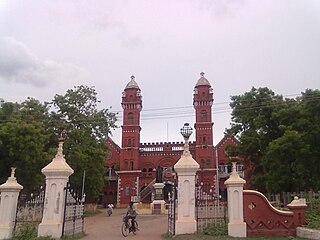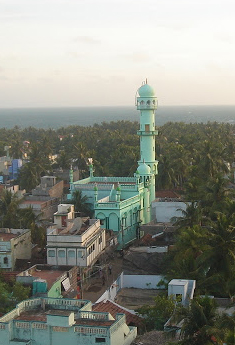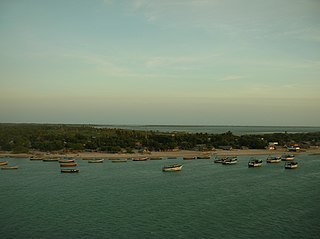
Rameswaram is a municipality in the Ramanathapuram district of the Indian state of Tamil Nadu. It is on Pamban Island separated from mainland India by the Pamban channel and is about 40 kilometres from Mannar Island, Sri Lanka. It is in the Gulf of Mannar, at the tip of the Indian peninsula. Pamban Island, also known as Rameswaram Island, is connected to mainland India by the Pamban Bridge. Rameswaram is the terminus of the railway line from Chennai and Madurai. Together with Varanasi, it is considered to be one of the holiest places in India to Hindus and is part of the Char Dham pilgrimage.

Karaikudi is the largest city and a City Corporation in Sivaganga district in the Indian state of Tamil Nadu. It is the 21st largest urban agglomeration of Tamil Nadu based on 2011 census data. It is part of the area commonly referred to as "Chettinad" and has been declared a City Municipal Corporation by the Government of Tamil Nadu, on account of the palatial houses built with limestone called Kaarai veedu. For this reason, the place is sometimes called Kaarai Nagar locally. The main municipality is spread across 33.75 km2 (13.03 sq mi) and the extended urban limit spreads about 115 km2 (44 sq mi) which undergoes major developments as part of Government Schemes.
Ramanathapuram, also known as Ramnad, is a city and a municipality in Ramanathapuram district in the Indian state of Tamil Nadu. It is the administrative headquarters of Ramanathapuram district and the second largest town in Ramanathapuram district. Soon the Ramanathapuram Civic body to be upgraded as Municipal Corporation, after merging with nearby panchayats.

Sivaganga is a City and headquarters of the Sivaganga district in the Indian state of Tamil Nadu.

The Vaigai is a river in the Tamil Nadu state of southern India; it passes through the towns of Theni, Madurai and Ramanathapuram. It originates in Varusanadu Hills, the Periyar Plateau of the Western Ghats range, and flows northeast through the Kambam Valley, which lies between the Palani Hills to the north and the Varushanad Hills to the south. The Vattaparai Falls are located on this river. As it rounds the eastern corner of the Varushanad Hills, the river turns southeast, running through the region of Pandya Nadu. Madurai, the largest city in the Pandya Nadu region and its ancient capital, lies on the Vaigai. The river empties into the Palk Bay near Alagankulam, close to Pamban Bridge in Ramanathapuram District.
Paramakudi or Paramagudi is the largest town in the district of Ramanathapuram in Tamil Nadu, India, with a population of over 95,579. It has been the taluk headquarters since the formation of Ramanathapuram District in 1918.

Sivaganga District is one of the 38 districts in Tamil Nadu state, India. This district was formed on 15 March 1985 by trifurcation of Ramanathapuram district into Ramanathapuram, Virudhunagar and Sivagangai districts. Sivaganga is the district headquarters. Karaikudi is the most populous Town as well as City Corporation in the district. It is bounded by Pudukkottai district on the Northeast, Tiruchirapalli district on the North, Ramanathapuram district on South East, Virudhunagar district on South West and Madurai District on the West. The area's other larger towns include Sivagangai, Kalayar Kovil, Devakottai, Manamadurai, ilayangudi, Thiruppuvanam, Singampunari and Tiruppattur. As of 2011, the district had a population of 1,339,101 with a sex ratio of 1,003 females for every 1,000 males.

Pudukkottai District is one of the 38 districts of Tamil Nadu state in southern India. The city of Pudukkottai is the district headquarters. It is also known colloquially as Pudhugai.
Manamadurai is a Municipality Town in Sivaganga district in the Indian state of Tamil Nadu. Manamadurai falls under Manamadurai Legislative assembly.
Pradani Muthirulappa Pillai, son of Sundra Pandya Pillai, of the 18th century was a Pradani of Ramnad estate during the reign of Muthuramalinga Sethupathy. As the king was a minor, just an infant, the Pradani took over the controls of a languishing kingdom and brought order and a sense of well-being by his careful planning and introduction of several tax and revenue reforms. Due to ideological differences that arose between the king and himself, he was forced to retire from his position in disgrace, was labelled as a traitor of India, and was forgotten. The Ramnad Manual amply records his administrative prowess and tax reforms.

Pudumadam is a village located in the Ramanathapuram district of the Indian state of Tamil Nadu. Situated near the old National Highway 49, which connects Kochi and Dhanushkodi, Pudumadam serves as a vital gateway to the picturesque Pamban Island. The village is approximately 25 kilometers away from the city of Ramanathapuram and 37 kilometers away from the renowned pilgrimage site of Rameswaram. The nearest train station is Uchippuli, located just 4 kilometers away from Pudumadam.

Pamban Island, also known as Rameswaram Island, is an island located between peninsular India and Sri Lanka, on the Adam's Bridge archipelago. The second largest island in the latter, Pamban Island belongs to India and forms the Rameswaram taluk of the Ramanathapuram district of the state of Tamil Nadu. It is the largest island in Tamil Nadu by area. The principal town in the island is the pilgrimage centre of Rameswaram.

Sivaganga Lok Sabha constituency is one of the 39 Lok Sabha (parliamentary) constituencies in Tamil Nadu, a state in southern India. Its Tamil Nadu Parliamentary Constituency number is 31.

The Kingdom of Ramnad or Ramnad estate was a permanently settled kingdom and later zamindari estate that existed in the Ramnad subdivision of the Madurai district and later Ramnad district of the erstwhile Madras Presidency in British India from 1601. It was ruled by the rajas also had the title of Sethupathi. Madurai Nayaks ruled the Ramnad area with the appointed chieftains between 14th to 16th century CE, and in 17th century CE the appointed governors expanded their power to establish "Ramnad Kingdom" which was also called as "Maravar Kingdom" by the British. In 1795 CE, after an heir dispute, they were reduced to the status of zamidari by the East India Company. After the independence of India in 1947 the estates were merged in the Union of India and in 1949 all rulers lost the ruling rights, privy purse was also finally abolished in 1971.

Rani Velu Nachiyar was a queen of Sivaganga estate from c. 1780–1790. She was the first Indian queen to wage war with the East India Company in India. She is known by Tamils as Veeramangai. With the support of Hyder Ali's army, feudal lords, the Maruthu Brothers, Dalit commanders, and Thandavarayan Pillai, she fought the East India company.

The Sethupathis are a Tamil clan of the Maravar community native to the Ramanathapuram and Sivaganga district of Tamil Nadu, India. They were from the 12th century considered independent kings in 16th century who ruled the Ramnad kingdom, also known as Maravar country. The male rulers of Ramnathapuram also bore the title of "Sethupathi" or "protector of the bridge", the bridge here referring to the legendary sacred Rama's Bridge, while female rulers bore the title "Nachiyar". Among the 72 poligars of the region, the Sethupathi stood first. This special position was conferred not based upon the revenue that his kingdom generated but because of his military prowess. Back in the beginning of the 18th century, the Sethupathi ruler could mobilize a considerable army, about 30,000 to 40,000 strong at short notice.
Thirupachethi is a Town in manamadurai block Sivagangai District on the highway of Madurai-Rameswaram (NH-49) in Tamil Nadu, India.
Appanur is a village in the Kadaladi Taluk of Ramanathapuram District in Tamil Nadu, India. It is located between Mudukulathur and Sayalgudi, on the State Highway 29 (SH29).

Poovanthi is a small village in the Sivaganga district of Tamil Nadu, India. Poovanthi is under the Manamadurai assembly constituency and Sivagangai Lok Sabha constituency. The primary source of income is agriculture.
Pirappan Valasai is a village in Mandapam block in Ramanathapuram District of Tamil Nadu, India.





















